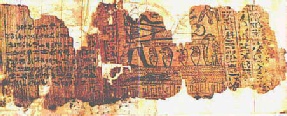

This overview of the controversy surrounding the Mormon Book of Abraham is part of
the major Field Guide profile Mormonism: The Church of Jesus Christ of Latter-
The Book of Abraham is a small document of five chapters, the longest only 31 "verses."
It is included in The Pearl of Great Price, a small volume of material designated
as part of the official "scripture" of the LDS Church. It is accepted by devout Mormons
as being the actual words of the Patriarch Abraham, inspired by God, and "written
by his own hand upon papyrus." It is accepted by Mormons that it was translated by
a miraculous, divine "gift of translation" by Mormon founder Joseph Smith during
the period 1835-
For the past four decades the Book of Abraham has been at the center of a storm of controversy swirling around the LDS Church because of tangible and credible evidence that it is not what Joseph Smith purported it to be at all.
Early History of the Book of Abraham
The Book of Mormon was first published in 1830. Joseph Smith claimed to have "translated" that book from inscriptions on "golden plates" that he had been led to by an "angel." By 1835 Smith had gathered a significant number of followers who accepted the Book of Mormon as a new revelation from God, and Joseph Smith as an inspired prophet. But their convictions had to be based almost entirely on blind faith in the testimony of Smith and a handful of other men who claimed to have seen the golden plates. Smith explained he had returned the golden plates to the angel upon completion of the work of translation. There was thus no way for supporters or critics to examine the plates and evaluate Smith's claims on any practical basis.
But in 1835 both supporters and critics were given an opportunity to examine Smith's claims to the miraculous gift of being able to translate a language he had never learned. In July of that year, a traveling exhibit of Egyptian mummies stopped in Kirtland, Ohio, center of Mormon activity at the time. Included in the exhibit were some Egyptian papyrus rolls, covered with Egyptian writings and illustrations. At that point in history, no one was able to translate hieroglyphics or other related Egyptian writing. The "Rosetta Stone," a large stone tablet that contained the same material written in parallel columns of Greek and Egyptian “Demotic” and hieroglyphic characters, had been discovered in 1799. And thus scholars had begun the laborious process of deciphering the Egyptian system of writing. But by the time Smith first saw the papryi in Kirtland in 1835, very limited progress had been made.
Enthusiastic Mormons informed Michael H. Chandler, the owner of the mummies and papyri, that their leader, Joseph Smith, had a remarkable ability to translate ancient languages. Chandler provided Smith with some of the documents, and was suitably impressed by Smith's claims for what some of the ancient characters signified. Shortly, the Mormons decided to purchase the whole collection from Chandler. Thus Smith was able to examine them more closely. And he announced, to the amazement of his followers, that one of the documents had been written by the Biblical Patriarch Joseph and the other by the Patriarch Abraham.
Smith spent portions of the rest of 1835 allegedly "translating" the document which
he identified as being the actual journal of Abraham himself, "written by his own
hand upon papyrus." He claimed to those who were helping him in the project (Smith
customarily dictated his material to others who acted as "scribes" for him) that
this was the very document that Moses had used in compiling the material for the
Book of Genesis in the Bible. Since this Book of Abraham (as it came to be called)
contained many more details than are included in Genesis, Smith implied that either
Moses had deliberately chosen to abridge what he included-
Mormon critics were later to note that the "extra" information found in the Book of Abraham but not in the Bible gave support to a number of controversial teachings that Smith had lately been attempting to enforce upon the LDS believers.
Smith finished about 40% of the content which is now in the Book of Abraham by the end of 1835. At the same time, he began work on a document which he called an "Egyptian Alphabet and Grammar." In this, he shared detailed insight into what he declared to be the finer points of understanding Egyptian writing.
He apparently did not work on the papyri again until 1842. Beginning in March, 1842,
the Mormon publication Times and Seasons began publishing regular bi-
From that point until his death in 1844, Smith used the Book of Abraham material in sermons, lectures, and other writings. In 1851 it was printed in pamphlet form in England as part of a small collection of Smith's writings entitled The Pearl of Great Price. In 1878, the US Mormons republished it again in similar form. And in 1880, the Book of Abraham, by unanimous vote of LDS authorities, was "canonized" as official scripture of the LDS Church.
However, the papyrus that Joseph Smith used in the creation of the Book of Abraham was no longer in the hands of the LDS leadership. After Smith's death in 1844, the papyrus became the property of his first wife, Emma. In the dispute over who was to inherit the role of Prophet in the LDS Church, Emma Smith refused to recognize the leadership of Brigham Young. Thus when the Mormons headed west to Utah under Young's leadership, they went without Emma, and without the papyrus. Emma's son Joseph Smith III later became the first Prophet of the Reformed Church of Jesus Christ of Latter Day Saints (RLDS). And at some point, the mummies and papyri were sold. Historical records of the time show that eventually at least a portion of the collection made its way to a museum in Chicago.
When the museum burned down in the great Chicago Fire of 1871, it was assumed by all that the papyri had been burnt up with it.
Lingering evidence
With the papyrus gone, the only evidences of what was on the original were the three
wood-
Copies of the Book of Abraham from 1835 to today have included Facsimile 1 as shown here, including the detailed description below it by Smith of what he believed to be portrayed in the illustration:
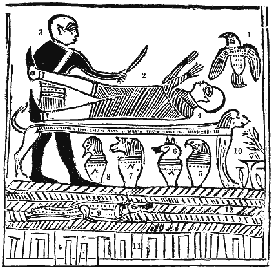
Fig. 1. The Angel of the Lord.
Fig. 2. Abraham fastened upon an altar.
Fig. 3. The
idolatrous priest of Elkenah attempting to offer up Abraham as a sacrifice.
Fig. 4.
The altar for sacrifice by the idolatrous priests, standing before the gods of Elkenah,
Libnah, Mahmackrah, Korash, and Pharaoh.
Fig. 5. The idolatrous god of Elkenah.
Fig.
6. The idolatrous god of Libnah.
Fig. 7. The idolatrous god of Mahmackrah.
Fig. 8.
The idolatrous god of Korash.
Fig. 9. The idolatrous god of Pharaoh.
Fig. 10. Abraham
in Egypt.
Fig. 11. Designed to represent the pillars of heaven, as understood by the
Egyptians.
Fig. 12. Raukeeyang, signifying expanse, or the firmament over our heads;
but in this case, in relation to this subject, the Egyptians meant it to signify
Shaumau, to be high, or the heavens, answering to the Hebrew word, Shaumahyeem.
The Book of Abraham includes Facsimile 2 as shown here, complete with the description and explanation that Smith gave to its contents.
 Fig. 1. Kolob, signifying the first creation, nearest to the celestial, or the residence
of God. First in government, the last pertaining to the measurement of time. The
measurement according to celestial time, which celestial time signifies one day to
a cubit. One day in Kolob is equal to a thousand years according to the measurement
of this earth, which is called by the Egyptians Jah-
Fig. 1. Kolob, signifying the first creation, nearest to the celestial, or the residence
of God. First in government, the last pertaining to the measurement of time. The
measurement according to celestial time, which celestial time signifies one day to
a cubit. One day in Kolob is equal to a thousand years according to the measurement
of this earth, which is called by the Egyptians Jah-
Fig. 2. Stands next to
Kolob, called by the Egyptians Oliblish, which is the next grand governing creation
near to the celestial or the place where God resides; holding the key of power also,
pertaining to other planets; as revealed from God to Abraham, as he offered sacrifice
upon an altar, which he had built unto the Lord.
Fig. 3. Is made to represent God,
sitting upon his throne, clothed with power and authority; with a crown of eternal
light upon his head; representing also the grand Key-
Fig. 4. Answers to the Hebrew word Raukeeyang,
signifying expanse, or the firmament of the heavens; also a numerical figure, in
Egyptian signifying one thousand; answering to the measuring of the time of Oliblish,
which is equal with Kolob in its revolution and in its measuring of time.
Fig. 5.
Is called in Egyptian Enish-
Fig. 6. Represents
this earth in its four quarters.
Fig. 7. Represents God sitting upon his throne, revealing
through the heavens the grand Key-
Fig. 8. Contains writings that
cannot be revealed unto the world; but is to be had in the Holy Temple of God.
Fig.
9. Ought not to be revealed at the present time.
Fig. 10. Also.
Fig. 11. Also. If the
world can find out these numbers, so let it be. Amen.
Figures 12, 13, 14, 15, 16,
17, 18, 19, 20, and 21 will be given in the own due time of the Lo
The Book of Abraham contains Facsimile 3 as shown here, including the descriptive material provided by Joseph Smith:
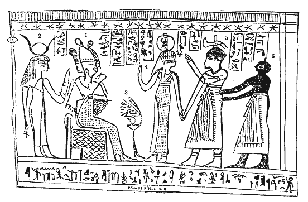
Fig. 1. Abraham sitting upon Pharaoh’s throne, by the politeness of the king, with
a crown upon his head, representing the Priesthood, as emblematical of the grand
Presidency in Heaven; with the scepter of justice and judgment in his hand.
Fig. 2.
King Pharaoh, whose name is given in the characters above his head.
Fig. 3. Signifies
Abraham in Egypt as given also in Figure 10 of Facsimile No. 1.
Fig. 4. Prince of
Pharaoh, King of Egypt, as written above the hand.
Fig. 5. Shulem, one of the king’s
principal waiters, as represented by the characters above his hand.
Fig. 6. Olimlah,
a slave belonging to the prince.
Abraham is reasoning upon the principles of Astronomy,
in the king’s court.
Even the most avid Mormon apologists in modern times have had a difficult time dealing with the obvious fact that figures 2 and 4 above are female figures, yet labeled by Smith as Pharoah and his son!
Smith's claims for this illustration were challenged as early as 1856:
Excerpt from Larson, By His Own Hand Upon Papyrus, p. 25
It was sometime during the year 1856, about five years after the Pearl of Great Price had been printed in England, when one of the small pamphlets found its way to the Louvre in Paris. There the facsimiles from the Book of Abraham, together with Joseph's accompanying explanations, were brought to the attention of M. Theodule Deveria. As one of the pioneers in the field of Egyptology, Deveria was asked to offer any comments on them he cared to make.
To Deveria the project probably did not seem worth the minimal effort it would require. However, he proceeded, and immediately recognized all three drawings as copies of rather common Egyptian funerary documents, of which he had examined hundreds. To be sure, most of the hieroglyphic and hieratic figures had been too poorly transcribed to be of much use for translation, and some elements in several of the drawings appeared to Deveria to be guesswork, probably incorrect restorations of missing sections of the original papyri. Still, most of the major elements fit very well into the established pattern associated with Egyptian mythology and the preparation of common funerary documents. Enough of the writing was legible for Deveria to decipher the names and titles of various Egyptian gods and goddesses, and on one of the drawings (Facsimile No. 3) he was able to determine the name of the deceased Egyptian for whom the scroll had originally been prepared. Concerning Facsimile No. 3 he wrote:
The deceased led by Ma into the presence of Osiris. His name is Horus, as may be seen in the prayer which is at the bottom of the picture, and which is addressed to the divinities of the four cardinal points.
Deveria dismissed Joseph's explanations as rambling nonsense. His comments first
appeared in French in a two-
More caustic comments were made about Smith's interpretations of the pictures in the Facsimiles in 1912:
From: Larson, p. 27-
At least that was how the Rt. Reverend Franklin S. Spalding, Episcopal Bishop of Utah, saw the situation in 1912. It was in that year that he decided to send copies of the three facsimiles from the Book of Abraham to some of the world's leading scholars of Egyptology, asking each for an independent assessment of Joseph Smith's interpretations.
The eight Egyptologists and Semitists who responded were unanimous in their scathing verdict: "Joseph Smith's interpretation of these cuts is a farrago of nonsense from beginning to end," came the report from the Metropolitan Museum of Art in New York, which added that "five minutes study in an Egyptian gallery of any museum should be enough to convince any educated man of the clumsiness of the imposture;" ". . . difficult to deal seriously with Smith's impudent fraud," wrote another from Oxford, England. "Smith has turned the Goddess into a king and Osiris into Abraham." From Chicago, ". . . very clearly demonstrates that he (Joseph Smith) was totally unacquainted with the significance of these documents and absolutely ignorant of the simplest facts of Egyptian Writing and civilization." And from London, ". . . the attempts to guess a meaning are too absurd to be noticed. It may be safely said that there is not one single word that is true in these explanations."
On and on the critiques went, giving the most comprehensive portrayal ever assembled of exactly what Joseph's papyri actually were: common Egyptian funerary texts.
And then came the challenge from Mormons, expressed by one Mormon writer:
In 1913, Mormon writer John Henry Evans pointed out in an article in the Church-
Evans' challenge, which he no doubt believed an impossibility at the time, was to come back to haunt the LDS Church.
Rising from the ashes
In 1966, a University of Utah researcher at the Metropolitan Museum of Art in New
York made a startling find in the archives of the museum. While looking at a collection
of some fragments of Egyptian papyrus rolls, he recognized one of the illustrations
on one of the fragments as nearly identical to the "Facsimile 1" wood-
In 1967, the Museum presented the papyri as a gift to the LDS Church. It was time for Evans' challenge to be taken up by Mormon critics.
The Church itself did some of the investigative work in comparing the results of modern studies in Egyptology applied to the papyri to the claims Joseph Smith had made for his work on the Book of Abraham. But when it became obvious that the results were going to be painfully uncomfortable for the Church, work became very slow. Outside researchers eventually obtained adequate copies of the material and began publishing their own results.
The bottom line of the investigations by all: One of the sections of papyrus was clearly part of the exact Egyptian writing from which Smith had claimed he "translated" the Book of Abraham! There were still handwritten copies of the original translation work available which showed the individual Egyptian figures down the left margin of a page, with the English translation right next to it. The handwriting on these copies was by Smith's regular scribes who helped him in his work. These Egyptian figures are clearly seen in a section of one of the recovered papyrus fragments, all in exactly the same order that they appear on the handwritten "translation" pages.
But scholar after scholar both inside and outside the LDS Church declared that there
was absolutely no connection between the text of the Book of Abraham and the actual
content of the Egyptian documents. The fragments of papyrus were clearly identified
by one and all as examples of completely ordinary "funerary" documents of ancient
Egypt. The section used by Smith was from a document called the Book of Breathings.
It contained the specific name of the deceased individual it had been prepared for,
and would have accompanied that person in their burial setting to provide them guidance
in the after life, as it included "spells" which the deceased could use in the afterlife
to learn to "breathe" again. Other papyrus fragments from the collection were from
the Egyptian Book of the Dead, an earlier collection of writings with a similar purpose.
The Book of Breathings was an abbreviated version of the Book of the Dead, used in
the later eras of Egyptian history. In fact, the papyrus used by Smith from which
to derive the Book of Abraham has been dated by scholars to the first century AD-
When the recovered papyrus was discovered in 1966, something else was discovered-
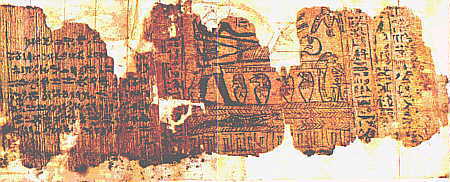
The study of Egyptian funerary art has progressed extensively during the intervening century, and it is painfully obvious to modern Egyptian scholars that Smith's speculations missed the mark. Below is a modern reconstruction of what the missing pieces likely contained, based on contents of similar funeral documents.
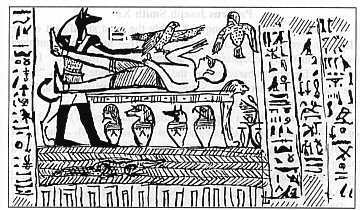
And instead of this being a portrayal of an attempt by an idolatrous priest to sacrifice
Abraham, contemporary Egyptian scholars identify it as a mythical stylized funerary
scene portraying the embalming and expected resurrection of Osiris, god of the underworld.
The human-
A number of modern Egyptologists have translated the writings connected to this picture, and their conclusions are all in close agreement. They merely convey information about the deceased for whom the Book of Breathings document was created.
Facsimile 2 Revisited
From: Larson, p. 104-
Joseph Smith identified the drawing shown on page 103 (Facsimile No. 2) as "Facsimile
from the Book of Abraham," and offered with it the elaborate "inspired explanation"
shown. It is actually a rather common funerary amulet termed a hypocephalus, so-
Egyptologists recognize Facsimile No. 2 as simply a hypocephalus, but there are also problems with that identification. As with the drawing of Facsimile No. 1, the restored parts of the Mormon hypocephalus do not correspond to genuine ancient Egyptian hypocephali.3 Also, just as with Facsimile No. 1, an incorrect restoration (by Smith) of a damaged original was suspected as the explanation for the differences.
While no photograph of the original papyrus from which Facsimile No. 2 was taken
is presently available, it is still possible to determine whether Joseph's hypocephalus
was damaged at the time it came into his possession. This is so because when the
collection of Smith's Egyptian Alphabet and Grammar papers was first published in
1966, one page was found to contain a fairly good pen and ink drawing of the Facsimile
No. 2 hypocephalus. However, there was one important distinction, for this drawing
showed a damaged, incomplete hypocephalus, with much of the right edge left blank,
including a wedge-
Some of these differences may seem minor to the inexperienced, but they are very noticeable to an expert. References to numbered "Figures" (i.e., Figure 1, Figure 2, etc.) correspond to the reproduction of Facsimile No. 2 found in the Pearl of Great Price. Joseph Smith numbered each section or figure to serve as a guide for his explanation (see caption of Facsimile No. 2 on p. 103).
The round faced creature in (upside-
The most dramatic error found on Facsimile No. 2 though, is the restoration of the
missing writing. While never offering an actual translation in his ''explanation,''
Smith nevertheless implies that this writing contains great and mysterious secrets
pertaining to God and the Temple (see caption of Facsimile No. 2, Figs. 8-
Facsimile 3 Revisited
Although the recovered papyri from the Metropolitan Museum did not contain the original of the illustration published in the Book of Abraham as Facsimile 3, modern Egyptologists have added their agreement to the earlier criticisms of the 1800s.
From: Larson, p. 108
Variations of the scene shown on page 109 (Facsimile No. 3) are probably the single
most common form of Egyptian funerary scene known -
Thus the individual Smith identified as the Patriarch Abraham … "reasoning upon astronomy in Pharoah's court" … is actually the pagan Egyptian god Osiris. And the individuals that Joseph Smith identified as Pharoah and his son were actually the goddess Isis, wife of Osiris, and the Egyptian goddess Maat.
Revisiting the Alphabet and Grammar
From: Larson, pp. 32-
Smith's ''Egyptian Alphabet and Grammar,'' as it has come to be called, had never really been lost or missing. For a long time it was simply ignored, and more recently it had been considered restricted. It was among that portion of early Church records the Mormons managed to take with them when they left Nauvoo in 1846, and it was included in the list of materials recorded in the Church Historian's Office Journal as having been deposited in the Historian's fireproof vault in Salt Lake City in 1855. There the manuscript lay, apparently all but forgotten for eighty years, before being "rediscovered" in 1935 during the course of some historical research by Dr. Sidney B. Sperry of Brigham Young University, James R. Clark, a student of Sperry's, and A. William Lund, Assistant Church Historian at the time.2
These documents were not released for public examination or study, however. For the time being their discovery was not even announced.3 It was not until 1938 that Dr. Sperry was allowed to publish a pair of rather indistinct photographs of two pages from the Alphabet and Grammar notebook which contained part of a translation manuscript from the Book of Abraham. The existence of the entire Grammar was still only hinted at for many years, and only a select handful of scholars and authorities within the LDS Church were allowed access to the material.4 This, despite the great historical significance attached to it by LDS writers like William Berrett, who proudly described it as Joseph Smith's "most notable achievement . . . the development of a Grammar for the Egyptian hieroglyphic form of writing," and "the first Egyptian Grammar in America."
Curiously, even as late as 1960 (by which time it had been known for some twenty-
Others who had occasion to come into contact with the material apparently disagreed with the Church's reluctance in the matter. Late in 1965 a microfilm copy of the entire work was "leaked" to Jerald and Sandra Tanner of Modern Microfilm Company (now Utah Lighthouse Ministry). The Tanners were former Mormons who were rapidly gaining a reputation for printing documents relating to Mormonism that, though authentic, made Church officials uncomfortable. By 1966 the Tanners had produced the first complete photomechanical reprint and transcription of the entire Egyptian Alphabet and Grammar.
But contrary to what most Mormons evidently expected, publication of the Alphabet and Grammar in no way substantiated Joseph Smith's ability to translate ancient Egyptian. Quite the opposite, for the book turned out to be nothing but page after page of nonsensical gibberish. Though it had apparently succeeded at one time in impressing unsophisticated minds, the work was unable to withstand the scrutiny of experts.
Professional Egyptologists to whom the Alphabet and Grammar was submitted for examination were quick to point out that the material in Joseph Smith's notebook bore no resemblance at all to any correct understanding of the ancient Egyptian language. As one of them, I. E. Edwards, put it, the whole work was, "largely a piece of imagination and lacking in any kind of scientific value." He added that it reminded him of "the writings of psychic practitioners which are sometimes sent to me." There were many similar verdicts, all confirming that the person responsible for what Berrett had glowingly called "the first Egyptian grammar in America" could not possibly have understood the ancient Egyptian language.
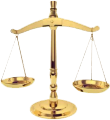
Evaluation
It is understandable that people with their whole lives invested in involvement with the LDS Church … perhaps even going back many generations in their family … would desperately attempt to find "excuses" for Joseph Smith in this matter of the Book of Abraham. After all, the issues at stake are at the very foundation of the organization. If Joseph Smith was actually utterly unable to translate Egyptian, and thus the Book of Abraham is just the product of his own imagination, then there is no reason to believe any of his other claims of authority as a Prophet, and the Restorer of Christianity after 1800 years of apostasy. This is no doubt a totally unacceptable outcome for those whose whole identity has been as Mormons for perhaps their entire life. And thus, indeed, the leadership of the organization has made numerous attempts to "explain away" the obvious conclusion of this whole matter, from the time the papyri were found at the Metropolitan Museum of Art to today. For that obvious conclusion, based on all of the facts at hand, is that the Book of Abraham is a total hoax.
While it is understandable for Mormons themselves to be willing to deceive themselves about this reality in order to maintain their "faith" in their founding Prophet, and thus not have to disrupt their lives, there is no reason at all for others to buy into such delusions.
And thus it is important for anyone even vaguely considering "buying into" the claims of Mormonism … perhaps as a result of visits from Mormon missionaries to their home … to clearly understand the facts of the controversy surrounding the Book of Abraham. If this brief overview has raised questions in the minds of any readers, they are urged to consult the references in the documentation section below for as much information as they could possibly need to come to their own conclusion on this matter.
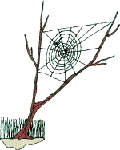
Web Documentation
The most comprehensive documentation, commentary, and examination available of the controversy surrounding the Book of Abraham is likely that available in the following book:
By His Own Hand Upon Papyrus: A New Look at the Joseph Smith Papyri
Larson, Charles M., Institute for Religious Research, Gr. Rapids, MI, 1985, revised 1992
The complete text of this book is now available on the Internet for free download at:
http://www.irr.org/mit/bhoh-
The brief overview of the circumstances surrounding the controversy about the Book of Abraham on this Field Guide website contains information compiled from Larson's book, and from a variety of other books and websites listed in the Bibliography at the end of the main profile on Mormonism on the Field Guide website.
Here is a link to an article written by Jerald and Sandra Tanner, authors of The Changing World of Mormonism, recommending Larson's book and examining some of the LDS Church's attempts to deal with his charges.
A good short summary and documentation of the most significant aspects of the controversy is provided in an article titled "The Book of Abraham Revisited" by H. Michael Marquardt, 1997, available on the Internet.
Unless otherwise noted, all original material on this Field Guide website
is © 2001-
Careful effort has been made to give credit as clearly as possible to any specific material quoted or ideas extensively adapted from any one resource. Corrections and clarifications regarding citations for any source material are welcome, and will be promptly added to any sections which are found to be inadequately documented as to source.
Return to Top of Page and the Navigation Bar

Book of Abraham papyrus-
Mormon Prophet Joseph Smith on Trial
